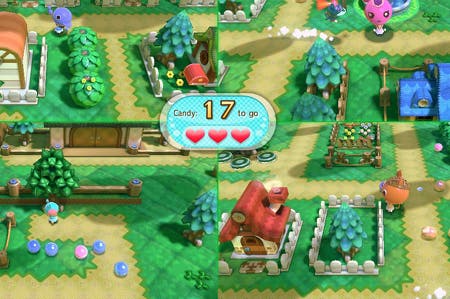Digital Foundry vs. Wii U at E3
A technical perspective on Nintendo's big re-reveal.
It's safe to say that last year's Wii U E3 debut left us with more questions than we had answers. It was clear that Nintendo has once again stepped back from the technological arms race that had cost its competitors billions in losses, and was focusing on controller-driven concept games that it felt had a greater chance of mainstream success. However, at the same time, the console was being released seven years after the debut of Xbox 360, so surely it had to reflect the generational leaps in technology we've seen since then? The demos suggested otherwise and, one year later, the evidence suggests that not a great deal has changed.
Of course, as we've demonstrated, tech specs don't really matter so much to Nintendo - a sentiment it is quite happy to put on the record. Its world-class development teams have the uncanny ability to create games that look as good as they play even on less accomplished kit, and the opportunities afforded by any modern processing hardware are immense.
Traditionally, the success of Nintendo's consoles has been entirely proportional to the quality of its own games and even its less successful systems like GameCube have turned a profit. By developing to the strengths of its own hardware, the company's dev teams have an uncanny ability to defy the technological limits of the host architecture. Combined with its unique take on game design, Nintendo games are quite like any other.
However, the reality is that the picture is very much different for third-party publishers - and it is here that the Wii U appears to remain on shaky ground. E3 2012 demonstrated clearly that the current-gen HD era is coming to a close and, to remain relevant to third parties once Durango and Orbis appear, we really needed to see a significant step beyond what was revealed last year. But Nintendo's E3 showing effectively confirms that there is no unambiguous, generational leap in raw processing power here compared to the current HD consoles, and prior claims that the machine hosts twice the power of the Xbox 360 clearly ring hollow.
"Wii U is bound to deliver some great Nintendo games but in a time of transition, has the current-gen focus on the tech limited its shelf-life with third party publishers?"

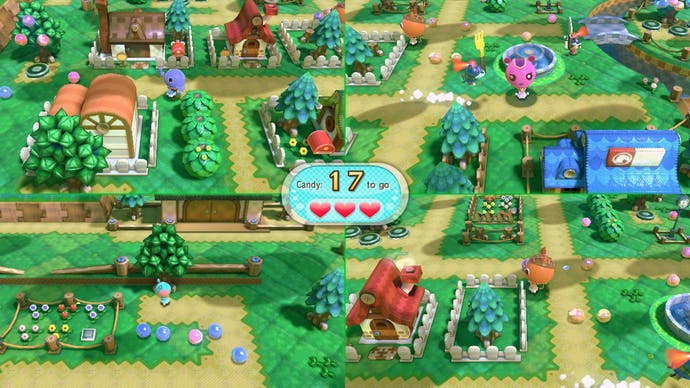
Instead, the assets released by Nintendo in particular are notable in how "lo-fi" they are: its own screenshots confirm that some of its most simplistic titles are running at basic 720p resolution with no kind of anti-aliasing whatsoever, just like its demos were a year ago. A closer look at the showcase titles Nintendo debuted at its E3 press conference also shows a puzzling lack of consistency in performance that we wouldn't expect to see in a console based on mature tech less than six months out from release, which we can only explain by the idea that the second screen is imposing more of a drain than we might have otherwise thought.
The company's spiritual successor to pack-in title Wii Sports - Nintendo Land - is an interesting example of this inconsistency. In theory this is "home territory" where Nintendo should revel in what it does best. While the concepts and charm are there, the trademark 60Hz update is inconsistent to say the least in certain areas - puzzling for such a visually sparse title.
To illustrate, here's the first analysis video we've put together. Direct feed is the premium from events like E3, but typical internet footage tops out at 30 frames per second, making analysis on smoother games impossible. Thankfully, HD broadcast footage retains full temporal resolution, and owing to the blanket coverage of the invaluable Spike TV, we can see the full fluidity of titles aspiring to 60Hz - and we can bring them to you on this page too.
"Nintendo Land targets the 60Hz refresh that is a core component in the raw playability of many of its most celebrated games."
While performance is fairly solid in the most simplistic mini-games, we see a fair amount of dropped frames in the initial clips based around the hub. Clearly the game is still a work-in-progress, but we remain somewhat perplexed as to why there should be issues like this at all since the scene being rendered shouldn't pose any kind of issue for a modern graphics core. However, what we didn't see is what the second screen is doing at this point. Generally speaking, Nintendo Land made heavy use of both on-screen split-screen and second-screen functionality simultaneously, and even on relatively simple games this will obviously have some performance implications. The Pac-Man-style Luigi's Mansion game sticks pretty closely to 60Hz, but it's also rendering a second discrete view for the second controller too, while the Zelda sub-game renders three views on the main screen with a fourth perspective on the tablet.
Not surprisingly for a series where its crisp frame-rate is so important in defining its superlative control system, New Super Mario Bros. U turned out to be exactly what we expected: a locked 60 frames per second from start to finish (aside from what looks to be a botched cut in the edit) and looking very, very nice indeed with some accomplished art direction and bags of character.
Nintendo has learned that the launch fortunes of its hardware are boosted significantly by a tentpole title based on its number one franchise, and while we've no doubt that this will be a fine game, the lack of any kind of showing for a Mario Galaxy-style offering was disappointing. With Shigeru Miyamoto effectively ruling out a new Zelda title for a long, long time, there was nothing from Nintendo on show that truly demonstrated the power of the hardware in the hands of some of the most celebrated first-party studios in the industry.
"New Super Mario Bros. U is hardly a technical workout for the Wii U hardware but it's sure to deliver in terms of artistic charm and essential playability."
What we did have, however, was the glorious Pikmin 3 demonstrated by none other than Miyamoto himself. Oozing charm, the game looks beautiful thanks to a combination of stylish, charming artwork, and wonderful animation both in terms of the characters and the surrounding environments. We also had a small glimpse at some of the more modern post-processing effects Nintendo's artists have been experimenting with, and it was pleasing to see how accomplished the final effect was.
Analysis confirms that Pikmin 3 runs at a fairly solid 30 frames per second, with just the occasional, minor drop in frame-rate when effects work pushes the hardware a little more. This does not tally with a report from the showfloor, where an unnamed rep said it will ship at 60Hz. Composition of the framebuffer once again strongly suggests native 720p resolution with no anti-aliasing, though some of the source material might imply that some kind of rough post-process edge-detect might be in play.
Of all of the Nintendo titles on display, it's Pikmin 3 that had the most modern attributes in terms of what was being rendered on-screen, and the adherence to 30 frames per second once again strongly suggests that the core hardware represents no fundamental leap in capabilities over what current-gen consoles offer. While we should fully expect optimisation efforts in the time before release, it's highly unlikely that ballpark performance will change radically.
"Pikmin 3 ramps up the level of graphical accomplishment, but frame-rate shifts down to 30FPS - matching its predecessors on Nintendo's older systems."
E3 2012 also affords us our first proper look at how third parties are making use of the Wii U hardware. The combination of a tri-core IBM CPU with a more modern AMD graphics core is an intriguing choice in that it provides a route to backwards compatibility with existing Wii titles but also offers a certain level of commonality with the architecture of the Xbox 360.
Here's a quick roundup of analysis based on the "sizzle" reels we saw of footage at the Nintendo conference, where existing PS3 and Xbox 360 versions are already available or are currently in development. As this was not live gameplay based on direct feeds from the console itself, we can't confirm the provenance of the footage and in the case of Mass Effect 3 we suspect that the PC version was being used.
| - | Ballpark Performance |
|---|---|
| Darksiders 2 | 15-60FPS |
| Mass Effect 3 | Cinematics 30FPS, Gameplay 60FPS |
| Tank Tank Tank | 30FPS |
| Tekken Tag Tournament 2 | Cinematics 30FPS, Gameplay 60FPS |
| Trine 2: Director's Cut | 30FPS |
| Aliens: Colonial Marines | 30FPS |
| Assassin's Creed 3 | 30FPS |
Updated 13/06/12: Rayman Legends was also in the "sizzle" feed and after double-checking it and the other games, we can definitely confirm that during transmission it was being shown at 30FPS. However, after hands-on play, we can confirm a 60Hz update with minor frame-rate drops. Similarly, the sizzle feed video of Ninja Gaiden: Razor's Edge was a locked 30FPS, but after going hands-on with the title we can confirm a v-synced 60 frames per second, with only minor frame-rate drops during effects-heavy Ninpo sequences. More soon.
We hesitate to dwell too much on what was shown here, but it is of interest - if only because this is how Nintendo chose to showcase Wii U's line-up - and certainly in several cases the use of what we should assume to be internet assets actually does some titles a disservice. In the case of these games, and the first-party titles too, our plan is to follow up as soon as we get direct access.
Third-party highlights in terms of platform exclusives were thin on the ground, but Ubisoft's ZombiU looked interesting - a first-person title that generates high tension by the fact that the player only has one life.
Conference footage here wasn't of much use to us, but a live feed on Spike TV once again confirms standard current-gen 720p30 performance with frame-rate drops, on what is hardly a visually complex game.
"ZombiU sees Ubisoft adopt Nintendo's approach of a concept-led title that doesn't rely upon state-of-the-art visuals - the game appears to operate at the console standard 720p30."
The new Batman: Arkham City Armored Edition was the obvious focus for Nintendo at the conference. Rocksteady's classic game has been augmented with a number of Wii U-exclusive features, mostly centred on the use of the tablet when playing with Bruce Wayne's "wonderful toys". But it is important for other reasons too - not least because it's the first chance we've had to assess the performance of Unreal Engine 3 on the new hardware. We've excised a range of direct-feed clips from the Nintendo conference, analysed them and come up with some interesting results.
Unreal Engine 3 titles on Xbox 360 and PlayStation 3 typically cap at 30 frames per second, dropping v-sync when frame-rate dips under the target. Existing versions of Batman: Arkham City follow the same pattern, though curiously its TriOviz 3D mode is completely unlocked, resulting in frame-rates at anything up to around 45FPS on Xbox 360, and a little lower on PlayStation 3. In normal 2D mode, the 30FPS cap is implemented in order to maintain an overall consistency to the whole experience.
On the Wii U, the entire presentation is v-synced from start to finish, and there's a definite feeling that performance suffers a little as a consequence, with some noticeable judder. However, it is worth checking out the full video of the entire walkthrough for additional context, as there is a rich amount of material often playing simultaneously on the second screen.
"Batman: Arkham City is our first look at how Wii U performs with Unreal Engine 3 and just a rudimentary comparison exposes many differences to the existing versions of the game."
Arkham City is an interesting case in that we have a game that by default has a whole series of enhancements available to the developers courtesy of the existing PC version. Many of these are DirectX 11-based, so almost certainly beyond the reach of the Wii U GPU, but there are a range of tweakables available within the inner workings of the Unreal Engine - draw distance and the like - that the creators of the new version could draw upon.
We pulled a number of shots from the Wii U footage released by Warner Bros. and went back to the original PC/Xbox 360/PS3 versions in order to get some idea of the direction taken, and came up with some intriguing conclusions.
First up, in this comparison shot taken from Two-Face's head-to-head with Catwoman, we find that the Wii U version offers up obvious improvements in terms of texture resolution, and something we didn't notice in our original Face-Off: the PC version runs this scene in real-time, while the Xbox 360 and PS3 versions appear to be offline renders presented via FMV, which may explain deficiencies in image quality.
As we're comparing a lossy Wii U grab up against pristine HDMI captures, we can't confirm whether Wii U is rendering this in real-time or not - but it is telling that even with this disadvantage the additional detail in the new game resolves easily. However, even if the Wii U title is using an offline render in a video sequence, it would demonstrate that brand new assets have been created for the Wii U version that would more fully utilise the 25GB of Blu-ray storage - something we didn't even see in the PS3 game.
"Areas where we see muggy FMVs on console Arkham City appear to show a much higher level of clarity on the new Wii U game."
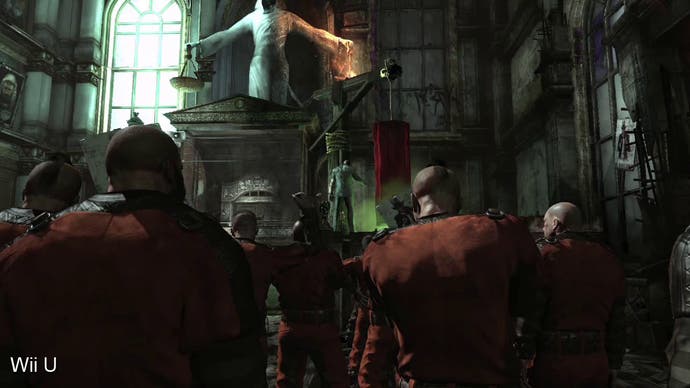
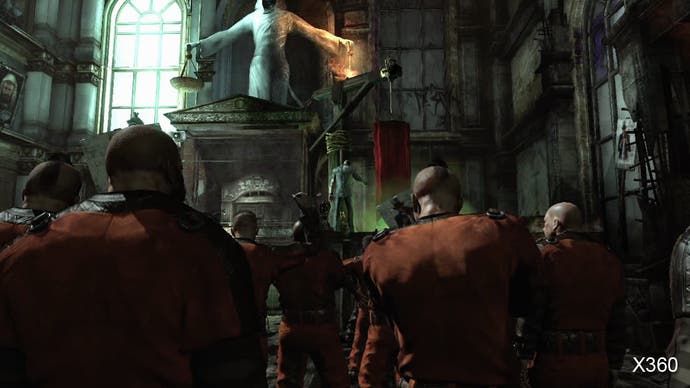
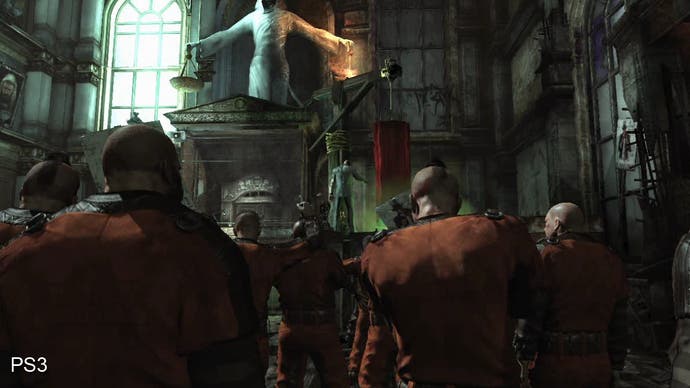
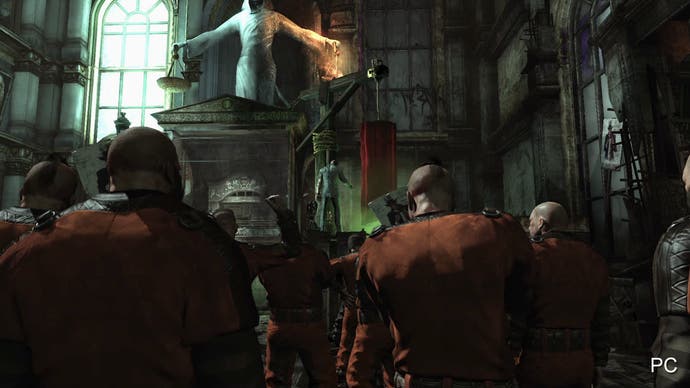
Now here's where things get really interesting. This next shot, taken from the exploding bell tower scene after Batman's first confrontation with Harley Quinn, demonstrates that the developers of the Wii U game have opted to go off in their own direction in a remarkable manner. We see a very close level of overall parity between Xbox 360, PS3 and the DX11 PC version running at 1080p/max settings. However, Wii U demonstrates a number of changes.
First of all, there are fundamental differences in the lighting model - positioning is different, and some light sources are added, others taken away. Wii U also seems to be sporting motion blur, different settings in the atmospheric rendering, along with the addition of brand new assets to the scene - not just the banners hanging from the tower, but new textures in some places too - it actually seems to be more accurately representing the look of the building when you first make your way towards it after saving Catwoman in the game's first chapter.
The scene is dramatically transformed but where there are some new additions, we also see cutbacks too. Long-range draw distance appears to be pared back noticeably, while in the mid-distance we see missing buildings, and the introduction of minor new scenery like additional water towers. Curiously, thin geometry seems to be entirely absent in places for some reason. We won't draw definitive conclusions until we're hands-on with actual code but it does seem to suggest that elements have been added and removed to better suit the capabilities of the hardware.
We're also fairly sure that the basic console 720p presentation has been augmented with FXAA or some equivalent post-process anti-aliasing, which is present in all the gameplay clips, but disabled when "detective vision" is in play. The PS3 and 360 versions feature no anti-aliasing at all.
"Enhanced anti-aliasing, LOD adjustments, texture differences - the forthcoming Arkham City Wii U Face-Off should be quite fascinating without even factoring in the tablet-based enhancements."


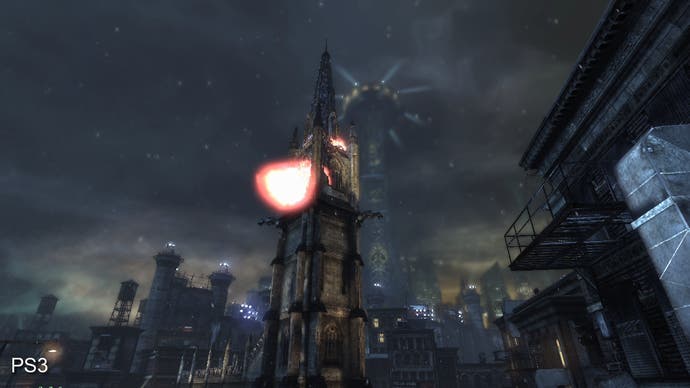

Reports continue to emerge from sources suggesting that Wii U is significantly more powerful than the current batch of titles may lead us to believe - the obvious inference being that these games have been created on incomplete hardware, perhaps with development tools that are still evolving, by studios unfamiliar with the hardware. In the case of Arkham City, we understand Warner Bros' Montreal studio is carrying out the work while Rocksteady continues on its own projects.
However, to survive the upcoming transition from the current HD consoles to their enormously improved successors, Wii U needs enough grunt to at least part-way bridge the generational gap - and there was scant evidence at E3 that the raw power required to do this was on tap. If it is a matter of getting to know the hardware and coaxing out maximum performance, the question is whether the third parties are prepared to invest the required time and effort. Looking back, it took a long, long time for the average standard of PS3 multi-platform titles to match what was being achieved on Xbox 360 and some might argue that Wii U doesn't have the luxury of time on its side.
In the medium term we should expect to see a new range of "cross-gen" titles come to market - the likes of the Unreal Engine 3-powered Star Wars 1313 and Ubisoft's spectacular Watch Dogs are likely to be amongst their number. These titles are almost certain to arrive on the existing HD consoles, but Wii U versions for these and many other key 2013 titles remain unannounced and there was a palpable lack of more current games in the launch line-up.
In fairness, this is almost certainly down to commercial considerations rather than technical ones: in economically uncertain times, should publishers commit significant resources to an unproven format? Will a Wii U game without exceptional second-screen support perform well? Our biggest concern about third-party support is that, even if the numbers eventually stack up, by the time the installed base is there, development on current-gen hardware may well be winding down. Factor in a first-party line-up that shows some promise in terms of innovative concepts, but lacks true next-gen Mario and Zelda titles that truly show what this hardware is capable of, and it's safe to say that Nintendo has it all to prove in the coming months.
